It turns out this is harder than I thought, so maybe someone has an easier way of doing this.
Since we need to create an image of the data, we will store them in a 2D array. We can then map the data to the integers 0 .. number of different data values and assign a color to each of them. The reason is that we want the final colormap to be equally spaced. So
value -2 --> integer 0 --> color orange
value 0 --> integer 1 --> color blue
and so on.
Having nicely spaced integers, we can use a ListedColormap on the image of newly created integer values.
import matplotlib.pyplot as plt
import numpy as np
import matplotlib.colors
# define the image as a 2D array
d = np.array([[-2,0],[1,3]])
# create a sorted list of all unique values from d
ticks = np.unique(d.flatten()).tolist()
# create a new array of same shape as d
# we will later use this to store values from 0 to number of unique values
dc = np.zeros(d.shape)
#fill the array dc
for i in range(d.shape[0]):
for j in range(d.shape[1]):
dc[i,j] = ticks.index(d[i,j])
# now we need n (= number of unique values) different colors
colors= ["orange", "blue", "red", "yellow"]
# and put them to a listed colormap
colormap = matplotlib.colors.ListedColormap(colors)
plt.figure(figsize=(5,3))
#plot the newly created array, shift the colorlimits,
# such that later the ticks are in the middle
im = plt.imshow(dc, cmap=colormap, interpolation="none", vmin=-0.5, vmax=len(colors)-0.5)
# create a colorbar with n different ticks
cbar = plt.colorbar(im, ticks=range(len(colors)) )
#set the ticklabels to the unique values from d
cbar.ax.set_yticklabels(ticks)
#set nice tickmarks on image
plt.gca().set_xticks(range(d.shape[1]))
plt.gca().set_yticks(range(d.shape[0]))
plt.show()

As it may not be intuitively clear how to get the array d in the shape needed for plotting with imshow, i.e. as 2D array, here are two ways of converting the input data columns:
import numpy as np
x = np.array([0,1,0,1])
y = np.array([ 0,0,1,1])
d_original = np.array([-2,0,1,3])
#### Method 1 ####
# Intuitive method.
# Assumption:
# * Indexing in x and y start at 0
# * every index pair occurs exactly once.
# Create an empty array of shape (n+1,m+1)
# where n is the maximum index in y and
# m is the maximum index in x
d = np.zeros((y.max()+1 , x.max()+1), dtype=np.int)
for k in range(len(d_original)) :
d[y[k],x[k]] = d_original[k]
print d
#### Method 2 ####
# Fast method
# Additional assumption:
# indizes in x and y are ordered exactly such
# that y is sorted ascendingly first,
# and for each index in y, x is sorted.
# In this case the original d array can bes simply reshaped
d2 = d_original.reshape((y.max()+1 , x.max()+1))
print d2

